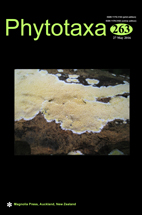Abstract
The family Anteagloniaceae comprises the genera, Anteaglonium and Flammeascoma. The family shares similar characters with taxa in the Hysteriales, but groups in the Pleosporales. No asexual morph is known in this family. In the present study we introduce a new species Anteaglonium thailandicum, re-examine A. parvulum and document its asexual morph. We observed different culture characters with similar morphology and molecular data for four strains of A. parvulum isolated from collections in Thailand. In this study we introduce A. thailandicum which has different hysterothecial characters as compared to A. parvulum and A. globosum, especially in the globose, roughened wall, indistinct slit, short subicula and short tomentum and also based on differences in LSU, SSU and TEF sequence data.

